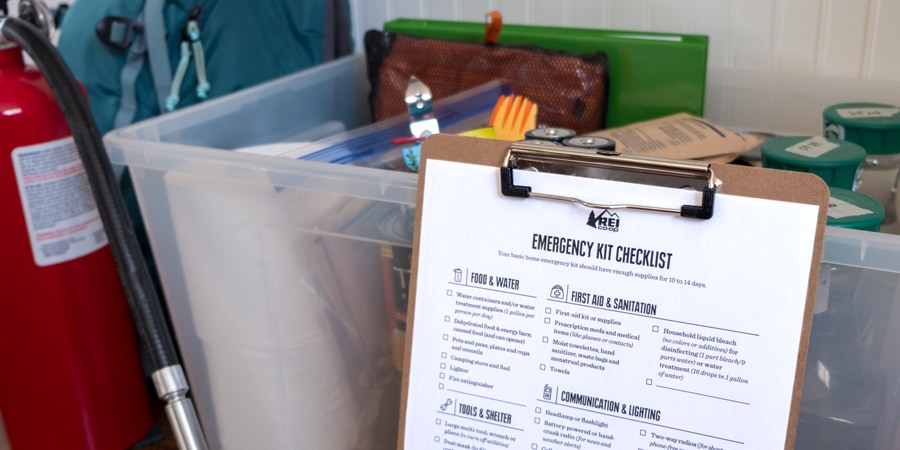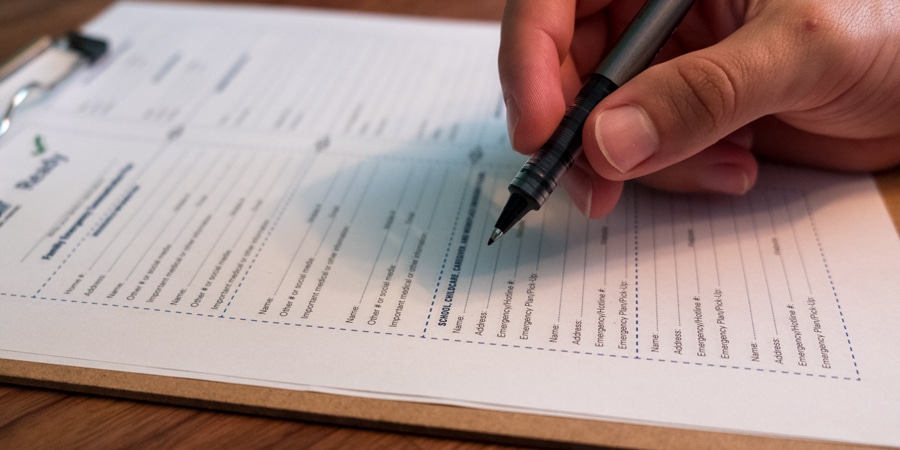The onslaught of disaster news can make preparing for one feel a little overwhelming. But each story also reminds us of the importance of preparation. The American Red Cross breaks down emergency preparedness into three basic steps:
- Get an emergency kit: If you're an outdoorsy person, you may already own many of the supplies you'll need, but you'll want to be sure they're easily accessible when you'll need them.
- Make a plan: This will include details about shelter, evacuation routes and how you will communicate with members of your household.
- Become informed: Learn how to get emergency alerts, research likely disasters in your area, and learn how to maintain your emergency kit once you've assembled it.
Read on for more details about each step.
Get an Emergency Preparedness Kit

Start the process of disaster prep by putting together your emergency kit. Because getting ready to go camping and preparing to shelter in place are very similar, a lot of rugged outdoor gear and supplies you might already own are ideal for an emergency kit. The emergency preparedness checklist below includes links to outdoor gear and supplies that can also be used in an emergency kit.
You may not want to purchase outdoor gear solely for your emergency preparedness needs, though, because more budget-friendly alternatives exist. Canned food, for example, is more affordable for a home kit than freeze-dried backpacking food.
This list is meant to be a starting point: Alter it, adding and subtracting items to meet your family needs and considering weather patterns and likely disasters in your area. To learn more about what to include in your kit, check out the Ready.gov list and Red Cross list.
Emergency Preparedness Kit Checklist
Your basic home emergency kit should have enough supplies for 10 to 14 days.
Printer-friendly version (PDF)
Food and Water
- Water containers and/or water treatment supplies to ensure 1 gallon per person per day
- Dehydrated food and energy bars; canned food (and can opener)
- Pots/pans, plates/cups and utensils
- Camping stove and fuel
- Lighter
- Fire extinguisher
First Aid and Sanitation
- First-aid kit (or make your own kit: first-aid checklist)
- Prescription meds and medical items (like glasses or contacts)
- Moist towelettes, hand sanitizer, waste bags and menstrual products
- Towels
- Household liquid bleach (no color or additives) for disinfecting (1 part bleach/9 parts water) or water treatment (16 drops in 1 gallon of water)
Tools and Shelter
- Large multi-tool; wrench or pliers to turn off utilities
- Mask (rated N95 or P100) to filter smoke and other airborne contaminants
- Plastic sheeting, work gloves and duct tape to shelter-in-place
- 1 sleeping bag or warm blanket per person
- Change of clothing
- Sturdy, comfortable walking shoes
- Warm clothing layers
- Rain jacket and pants
Communication and Lighting
- Headlamp or flashlight
- Battery-powered or hand-crank radio for news and National Oceanic and Atmospheric Administration (NOAA) weather alerts
- Cellphones and chargers
- Two-way radios for short range, phone-free communication
- Extra batteries for all electronics
- Whistle to signal for help
Evacuation and Documentation
All of these items should be stored in a waterproof container.
- Extra set of car keys and house keys
- Local maps
- Cash (in small bills because businesses might not be able to make change)
- Copies of important documents (Rx list, medical history, deed/lease to home, passports, birth certificates, insurance policies, etc.)
- A copy of your emergency plan
Kids, Pets and Entertainment
- Infant formula and bottles; diapers
- Pet food, ID, meds and supplies; extra water for your pet
- Paper and pencil
- Books, games, puzzles, including those for children
Storage for Kit Supplies
- Plastic tub for a home kit
- Daypack for a personal kit
Additional Emergency Kit Tips
Though not part of a basic preparedness checklist, the gear below can prove invaluable for disaster response:
- Portable power devices: Many disasters knock out power, so a solar charger and/or power pack are handy for phones and other small electronics (for large household appliances, you need a generator).
- Electric lanterns: If you don't have a home generator, it's nice to have a light source other than your headlamp (plus extra batteries)
- Kayaks, paddles and PFDs: If floodwaters rise quickly, it's nice to have a lifeboat (inflatable kayaks are easier to store).
- Camping tent: If the house isn't structurally sound (which might happen after a tornado or an earthquake) and the route to a local shelter is blocked, then a tent can serve as an emergency shelter.
- Mountain bikes: If evacuation roads are blocked by trees or impassable traffic, a rugged two-wheeler can go where larger vehicles cannot.
Make a personal-size kit: You can also use the above emergency kit checklist to create the personal-size evacuation kit you stow in your vehicle. Stow another personal kit at work if you don't always commute in your own car. A personal-size kit should have three days of supplies. To make one, pare the list down to the bare necessities, like the Ten Essentials needed for survival outdoors. Every item in this kit must be small and packable. You can buy prepackaged emergency kits, in a variety of sizes, though you should always supplement any kit to meet personal needs.
Keep track of anything you remove from your kit: It's OK to remove items (like a headlamp or first-aid kit) from an emergency kit to use on an outdoor trip, but be diligent in tracking and returning those items afterward. And don't remove emergency kit items if other family members need them. Mom, for example, shouldn't poach backpacking supplies if dad is staying home with the kids.
Make an Emergency Plan

Consider your family's unique circumstances, like where young kids or aging parents are likely to be at any given time. Then write down and make copies of your emergency plan. To make an emergency plan, answer these three questions:
- What is my shelter plan? Record locations of designated mass shelters near you, family options out of town and how to find new shelters created during an emergency.
- What is my evacuation route? Record the best way to reach shelters, places outside the home you will gather and how to communicate about your destinations.
- How will I communicate with family/household members? Create a detailed written list of all potential contact numbers; have one key contact who is out of the area because local communication networks can get overwhelmed and it is often easier to reach someone out of the area to coordinate messages.
Review and practice the plan. Do a drill, for example, where everyone exits the home and meets up in your designated neighborhood gathering spot for emergencies like a house fire. Make sure everyone has copies of your family plan (at home and work), and that family care providers also have details they need, especially contact details.
Become Informed About Emergency Preparedness
It's time to embrace your inner emergency preparedness nerd and become more informed about disasters and emergencies likely to occur where you live. This is even more important if you're a parent or spend any time in a leadership role because you'll likely have others depending on you to make decisions. (Reading articles like this is a great place to start.) Knowledge is preparedness power:
- Learn about how to receive emergency alerts and warnings. Cellphone providers, broadcasting and streaming services, and NOAA all send them out.
- Research likely disasters where you live: Know ahead of time how to handle hurricanes/flooding in Florida or Texas, for example.
- Learn how to maintain your kit. Revisit your kits yearly to assess changing needs. And some supplies expire, so it's important to check and replenish as needed every six months. For more details, read How to Maintain Your Emergency Kit.
Additional Emergency Preparedness Resources
Both Ready.gov, and the American Red Cross offer comprehensive info about how to plan and prepare for a full range of emergencies and disasters.
In addition, many REI stores teach emergency preparedness classes that go beyond basic kit preparation:

